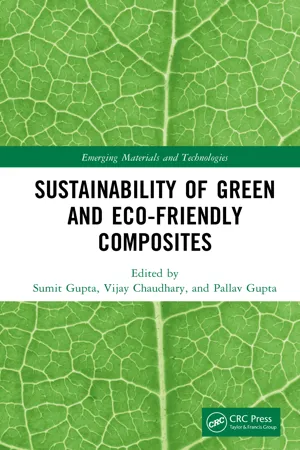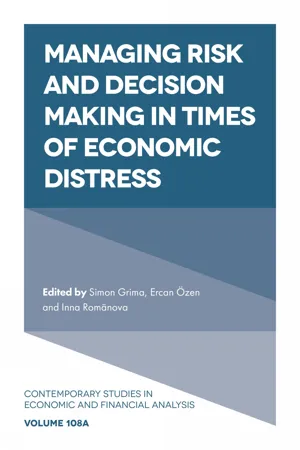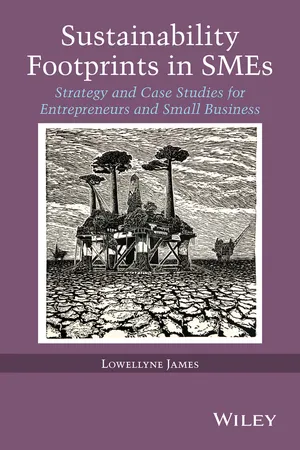Technology & Engineering
Carbon Footprint of Materials
The carbon footprint of materials refers to the total amount of greenhouse gases emitted during the production, transportation, and disposal of a material. It is a measure of the environmental impact of a material, taking into account its entire lifecycle. Understanding the carbon footprint of materials is important for making sustainable choices in engineering and technology.
Written by Perlego with AI-assistance
Related key terms
Related key terms
1 of 4
Related key terms
1 of 3
9 Key excerpts on "Carbon Footprint of Materials"
- eBook - ePub
The Rise and Rise of Indicators
Their History and Geography
- Stephen Morse(Author)
- 2019(Publication Date)
- Routledge(Publisher)
2 e), which reflects the fact that there are many gases that have the capacity to act as greenhouse gases, and, while carbon dioxide tends to receive all the bad publicity, there are others that may be present at much lower concentrations but be far more effective at keeping heat in. Methane, for example, is a greenhouse gas often released as a pollutant in industrial processes and agriculture, and it is far more effective at keeping heat in. The emission of 1 tonne of methane is equivalent in terms of global warming potential to 25 tonnes of carbon dioxide (Wright et al., 2011). Remarkably, there is one gas, sulphur hexafluoride, used for a variety of purposes, including as an insulator in the electrical industry, which is 22,800 times more potent than carbon dioxide as a greenhouse gas (Wright et al., 2011). Thus, 1 tonne of sulphur hexafluoride has the equivalent greenhouse effect of 22,800 tonnes of carbon dioxide.The carbon footprint is important in terms of climate change and has received much political and media attention, although arguably nowhere near enough. Efforts are now being brought to bear on reducing our use of fossil fuels by substitution with other renewable energy sources such as solar and wind. We can also calculate the ‘embodied’ carbon in a manufactured product or service and that provides a basis for reduction, perhaps by introducing new processes. However, calculating the carbon footprint for a product or service can be complicated, especially as we must consider the carbon emissions from ‘cradle-to- grave’. For example, when we consider the carbon footprint of a car it is not just its manufacture we have to consider but also its maintenance and disposal at the end of its useful life; every step in that cradle-to-grave sequence has a cost in terms of carbon emissions, and disposal at the end of the product’s life is no different. However, calculating the embedded carbon footprint flowing from all these processes is necessary but challenging, and I do not wish to take the reader down that road (pardon the pun). The interested reader is referred to the excellent introduction to carbon footprinting by Mike Berners-Lee entitled How Bad Are Bananas? The Carbon Footprint of Everything (2011). For more technical treatments of the carbon footprint and detailed case studies, the reader is referred to The Carbon Footprint Handbook (Muthu, 2016) and Carbon Footprint Analysis - Sumit Gupta, Vijay Chaudhary, Pallav Gupta, Sumit Gupta, Vijay Chaudhary, Pallav Gupta(Authors)
- 2023(Publication Date)
- CRC Press(Publisher)
Pertsova, 2007 ).FIGURE 13.4Different recycling methods that are used for green composites.Source:Karuppannan Gopalraj & Kärki (2020)The term “footprint” suggests a measurement or expression in area-based units. Closely related to carbon footprints are “ecological footprints” which are measured in hectares or “global hectares.” This is an interesting proposition to decide if carbon footprint should be a pressure indicator which would express the amount of carbon emission or if it would indicate the impact and quantify the amount of carbon dioxide released. In some cases carbon footprints can be used as a broad substitute for the emission of greenhouse gases which includes carbon dioxide. Some researchers describe carbon footprint as the “carbon weight” which is produced per person or an activity in kilograms and tonnes (Lu et al., 2019 ). The carbon footprints may hence be defined as a degree of the quantity of carbon or carbon dioxide emission which is caused directly or indirectly by an activity or an individual, which is accrued over the life stages of a product.In general the activity of an individual, population, company, industry, government, organization etc. produces or uses good and services that can have direct or indirect carbon emission can be taken into account. A greenhouse gas indicator should include all the types of gases that may include carbon dioxide or methane which are relevent and most comman greenhouse gases and also other substance which have global warming potential. But due to less data availablity, it is difficult to quantify them. Therefore in these cases we can only include carbon dioxide as the most practical and clear greenhouse gas taken into account to have a carbon footprint (Pertsova, 2007- Ji?í Jaromír Klemeš(Author)
- 2015(Publication Date)
- Butterworth-Heinemann(Publisher)
It illustrates the global life cycle-wide material extraction and the final consumption of material within a region, occurring either within a country or beyond borders of countries (Giljum et al., 2013a). Material footprint is a newer term for “ecological rucksacks” (Giljum et al., 2013a). Another definition of material footprint is that it is an indicator for measuring and optimizing the resource consumption of products and their ingredients and the production processes along the whole value chain (Lettenmeier et al., 2012). Emission footprint The emission footprint represents the quantities of product or service-created emissions into the air (e.g., SO 2, particles, CO, CO 2), water (e.g., chemical oxygen demand (COD), nitrogen, and phosphorus), and soil (through spillage in the soil). Emission footprints are calculated on a per-area basis. The conversion of emissions is calculated according to the principle that anthropogenic mass flows must not alter the qualities of local compartments. Maximum flows are defined based on the naturally existing qualities of the compartments and their replenishment rate per unit area. For emissions to soil, the replenishment rate is given by the decomposition of biomass to humus (measured by the production of compost by biomass). For groundwater, this is the seepage rate (given by local precipitation). For emissions into the air, the natural exchange of substances between forests and air per unit area is taken as a basis of comparison between natural and anthropogenic flows. Different emissions to air are not weighted, because only the largest dissipation areas are to be considered- Simon Grima, Ercan Özen, Inna Rom?nova, Inna Rom?nova, Inna Rom?nova, Inna Rom?nova(Authors)
- 2022(Publication Date)
- Emerald Publishing Limited(Publisher)
The calculation of institutional carbon footprint is more detailed. Carbon emissions from every sort of equipment in production by all departments are taken into account. Among these, direct carbon footprint is carbon footprint, formed by fossil fuels used for activities like heating and production and fossil fuels used for vehicles. Indirect carbon footprint are emissions, which consist of carbon emissions arising from electrical energy institutes and carbon emissions depending on steam, cooling water, and warm water some institutes buy from others (Bekiroğlu, 2011, pp. 7–8). 5. SUSTAINABLE (GREEN) CONSUMPTION AND CARBON FOOTPRINT With reference to the use of natural resources, sustainable consumption used to express consuming goods and services which are sensitive and reduce pollution to minimum or, in other words, environmentally sensitive consumption should be carefully followed by the government, non-profit organisations and businesses (World Business Council for Sustainable Development, 2008, p. 7). Sustainable consumption is a method whereby the individuals will have specific consumption habits, and which they will obtain thanks to their political and environmental preferences (Seyfang, 2005, p. 290). Sustainable consumption is defined in the form of ‘reasonably and rationally using natural resources to raise life standards’ (Yates, 2008, p. 96). For individuals to attain sustainable consumption behaviors, the ‘3R’ concept was introduced. This is expressed as ‘reducing, reusing, and recycling’. Reducing means reducing materials, energy, and water consumption as much as possible, in order to be able to produce as little waste as possible and save energy as much as possible. Reusing is the effort of reusing a product or energy several times, if possible. Recycling is only used for the products that can be reused (Yates, 2008, p. 96)- eBook - ePub
Sustainability Footprints in SMEs
Strategy and Case Studies for Entrepreneurs and Small Business
- Lowellyne James(Author)
- 2014(Publication Date)
- Wiley(Publisher)
described as the productive land area required to absorb CO 2 produced by a human population during the life as a chemical compound [35]. Originally an environmental science concept, the carbon footprint began life as a GWP indicator [35]. The term carbon footprint is used interchangeably with terms such as embodied carbon, carbon content, embedded carbon, carbon flows, virtual carbon, climate footprint, and GHG footprint [35]. Carbon accounting is not without its own contradictions as its definition depends on the technical orientation of the user group—as a technique for verifying carbon emissions for scientists, guidelines for comparing emissions when defined by diplomats, an account of emission obligations or rights that can be assessed under various trading schemes with carbon finance practitioners considering carbon accounting as the quantification of emissions in relation to a baseline, enabling the sale or purchase of carbon credits within carbon trading schemes [17, 36–39]—in essence the colonizing of carbon accounting to suit commonly shared beliefs and specialist expertise [17, 27]. These various interpretations contributed to carbon accounting being identified as in Fig. 4.1. Figure 4.1 Carbon accounting definition. Source: Ascui and Lovell [17]. © Emerald. This definition highlights disconnect between the quantification of GHG emissions and the monetization of GHG emissions, which differentiates carbon accounting from traditional forms of accounting methods [27]. This multivariate interpretation of “carbon” has contributed to an atmosphere of technical exclusivity, misinterpretation leading to fraud within carbon and GHG accounts in carbon markets undermining climate change initiatives [17, 27]. Despite terminological issues, carbon trading and taxation have transformed carbon footprint into a “spatial indicator” of impact; hence, some scholars have argued for the use of the term carbon mass or carbon weight [35, 40, 41] - eBook - ePub
The Green Guide For Business
The Ultimate Environment Handbook for Businesses of All Sizes
- Chris Goodall(Author)
- 2010(Publication Date)
- Profile Books(Publisher)
Oxford English Dictionary. It can be broadly defined as:The total amount of direct and indirect carbon dioxide, and other greenhouse gas, emissions attributable to an activity.An ‘activity’ can include just about anything, as most actions or objects associated with modern living are in turn linked to activities that require energy and are thus responsible for generating greenhouse-gas emissions at some point in their life cycle. Every time you travel, for example, you are responsible for various greenhouse-gas emissions. When you drive, fly, take a bus or train, this uses energy – in the form of petrol, diesel, kerosene or electricity (the latter is itself most often generated using gas or coal). These fuels, collectively termed fossil fuels (they were originally formed from fossilised remains), release energy and carbon-dioxide emissions when they burn.Even if you walk or cycle, you leave a carbon footprint. Why? Well, the energy you use to walk the dog or pedal to the shops comes from the calories in your food. And, most likely, fossil fuels were used to deliver those calories to your plate. Your bicycle would also have required energy, albeit a relatively small amount, to manufacture it.However, for organisations, the most challenging thing is deciding what to include in your footprint and what to exclude. For example, should you include the impact of commuting to work or the energy used by the supplier of your office computers? What about the food eaten at the staff canteen or the emissions from freight?On a bank statement, it is easy to see the state of your finances as the bank has kindly collected together in one place all your credits, debits, transfers and so on. With greenhouse gases, there is no similar accounting framework, no simple way to create a ‘carbon statement’. Unlike financial transactions, there are no clear boundaries to your ‘carbon account’. - Arshad Ahmed, John Sturges(Authors)
- 2014(Publication Date)
- Routledge(Publisher)
all of the outputs, and it is these waste outputs that can cause so many environmental problems. If we are not to modify the Earth’s ecosystems to the point where they will no longer support human life, there are certain limits or boundaries that we must not exceed. Lynas (2011) has indicated what these boundaries or limits might be, and he identifies nine in all. These are: climate change (carbon emissions), biodiversity, nitrogen, land use, fresh water, toxic emissions, aerosols, ocean acidification and ozone. The extraction and use of materials has impacts in most of these areas.However, not all of the materials of construction will have equally large environmental effects; Allwood and Cullen (2012) point out that just five materials are responsible for 55 per cent of all industrial emissions. These materials are steel, cement, plastic, paper and aluminium, and all of them are utilised in building construction.22.6 Indices of environmental impactIf we are to precisely measure the extent of environmental impact of the manufacture of building materials, we need to take account of all the various types of impact that we have identified so far. In Section 22.4 we identified various impacts, and indices have been developed by engineers and environmentalists for five of these impacts. We shall look at these five first; they evaluate the impact of energy consumption, emission of carbon dioxide, production of waste and spoil, assessing the footprint of the manufacturing plant and process, and water usage.22.6.1 Embodied energy
This index measures the amount of energy consumed in making a unit quantity of the required material (usually 1 kg or 1 tonne). It is given in the units of joules per kilogram or joules per tonne. It is not a measure of energy ‘contained’ within the material, but its value will depend upon the efficiency of the production plant. For example, during the Second World War it probably took 100 GJ of energy to produce a tonne of steel. In 2011, in a modern plant it will take no more than 22–23 GJ of energy to produce a tonne of steel.Units : GJ/tonne or MJ/kg.22.6.2 Embodied carbon dioxide
This index measures the emissions of CO2 in making a unit quantity of material. It is measured in terms of tonnes of CO2 emitted per tonne of product. CO2- Anne Gorman, Miriam Delaney(Authors)
- 2022(Publication Date)
- Laurence King Publishing(Publisher)
In terms of climate change ‘carbon’ is sometimes used as shorthand for carbon dioxide (CO 2), which is the most significant greenhouse gas released by human activity. It traps heat in the atmosphere close to the surface of the earth. Greenhouse effect A naturally occurring process whereby the atmosphere close to the earth acts to insulate it. High levels of CO 2 caused by human activity have increased the greenhouse effect, leading to rising temperatures. Fossil fuels Fuels derived from the decomposition of naturally occurring organisms. Gas, petroleum, oil, peat and coal are all fossil fuels. When burned, these finite resources release CO 2, which can increase the greenhouse effect. Carbon footprint The total amount of greenhouse gas emissions that come from the production, use and end-of-life of a human activity. In construction the carbon footprint is the measurement of the environmental impact of a building material, construction system or building. Life-cycle analysis (or life-cycle assessment) A methodology for assessing environmental impacts associated with all stages of the life cycle of a service, a product or an activity. It is sometimes called ‘cradle to grave’ analysis. Passive House (or Passiv-haus) An energy standard for buildings that are designed to significantly reduce their heating needs and energy demand, and so have a reduced ecological impact. It concerns the design, construction and running of buildings. Retrofit In construction retrofitting refers to the addition of new technologies or features to older buildings to reduce their environmental impact and minimize energy waste- eBook - ePub
- Subramanian Senthilkannan Muthu(Author)
- 2017(Publication Date)
- Woodhead Publishing(Publisher)
10 ]. Apart from these major drawbacks, minor effects of global warming are a rise in sea level, changes in climatic conditions and lessened snow cover, which may influence the ecosystem as well as human activities. Burning of fossil fuels to generate energy could increase the carbon footprint into the atmosphere.The carbon cycle is an important cycle of the earth, and human activity is significantly influencing the various physical and chemical activities responsible for the earth’s climate [11] . Atmospheric concentrations of CO2 have been increasing for decades, creating profound implications for future climate change, the productivity of agriculture and the function of ecosystems. Much research has demonstrated that global warming mainly results from the increasing emissions of GHGs as a result of human activities. The major contributing factor to global warming is CO2 , which accounts for approximately 80% of emissions from developed economies. To keep track of one’s GHG emissions is to be aware of one’s carbon footprint. Carbon footprints are a measure of the impact that human activity has on the environment in terms of the quantity of CO2 equivalents; it is measured in kilograms or tons.The carbon footprint assessment (CFP) is an important approach for the control and management of GHG emissions. The method is based on the life-cycle concept and is used to assess GHGs released during the manufacture of goods and services, either throughout their entire life cycle or within specified temporal or spatial boundaries. The carbon footprint is the total amount of CO2 and other GHGs released during the full life cycle of a process or product. It is calculated for the period of 1 year and is expressed in terms of the amount of CO2 or its equivalent of other GHGs released [12] . Other kinds of GHGs which could be released are ozone and methane [13 ,14 ]. These GHGs are also considered for the evaluation of the carbon footprint but they are normally converted into equivalent CO2 (i.e., the amount of CO2 that could lead to a similar influence on global warming).The major idea behind CFP originates from life-cycle analysis (LCA). As per the International Organization for Standardization (ISO) 14040 series, an LCA involves a methodical set of measures for compiling and investigating the inputs and outputs of products and energy and the related environmental impacts directly related to the functioning of a product through its entire life cycle, and within a given set of boundary conditions [15] . When accounting for CO2 (or other GHG) emissions along the life cycle of a product, the term ‘carbon footprint’ is used. The idea behind ‘footprint’ comes from an ecological footprint accounting system, in which ‘ecological footprint’ is used as an indicator to measure the consumption of resources and waste assimilation necessities based on the economy or human population by means of a productive land area [16]
Index pages curate the most relevant extracts from our library of academic textbooks. They’ve been created using an in-house natural language model (NLM), each adding context and meaning to key research topics.
Explore more topic indexes
Explore more topic indexes
1 of 6
Explore more topic indexes
1 of 4








